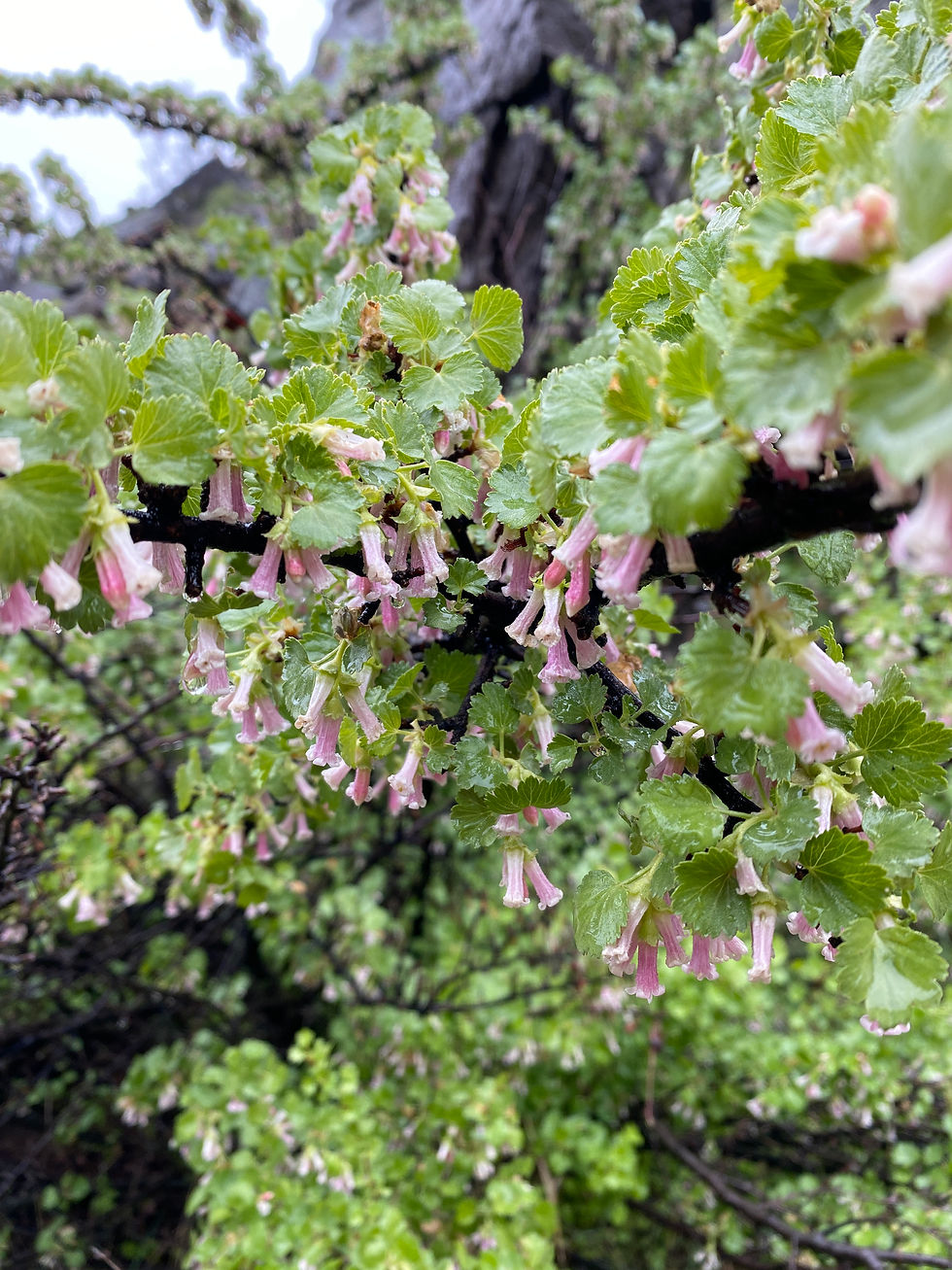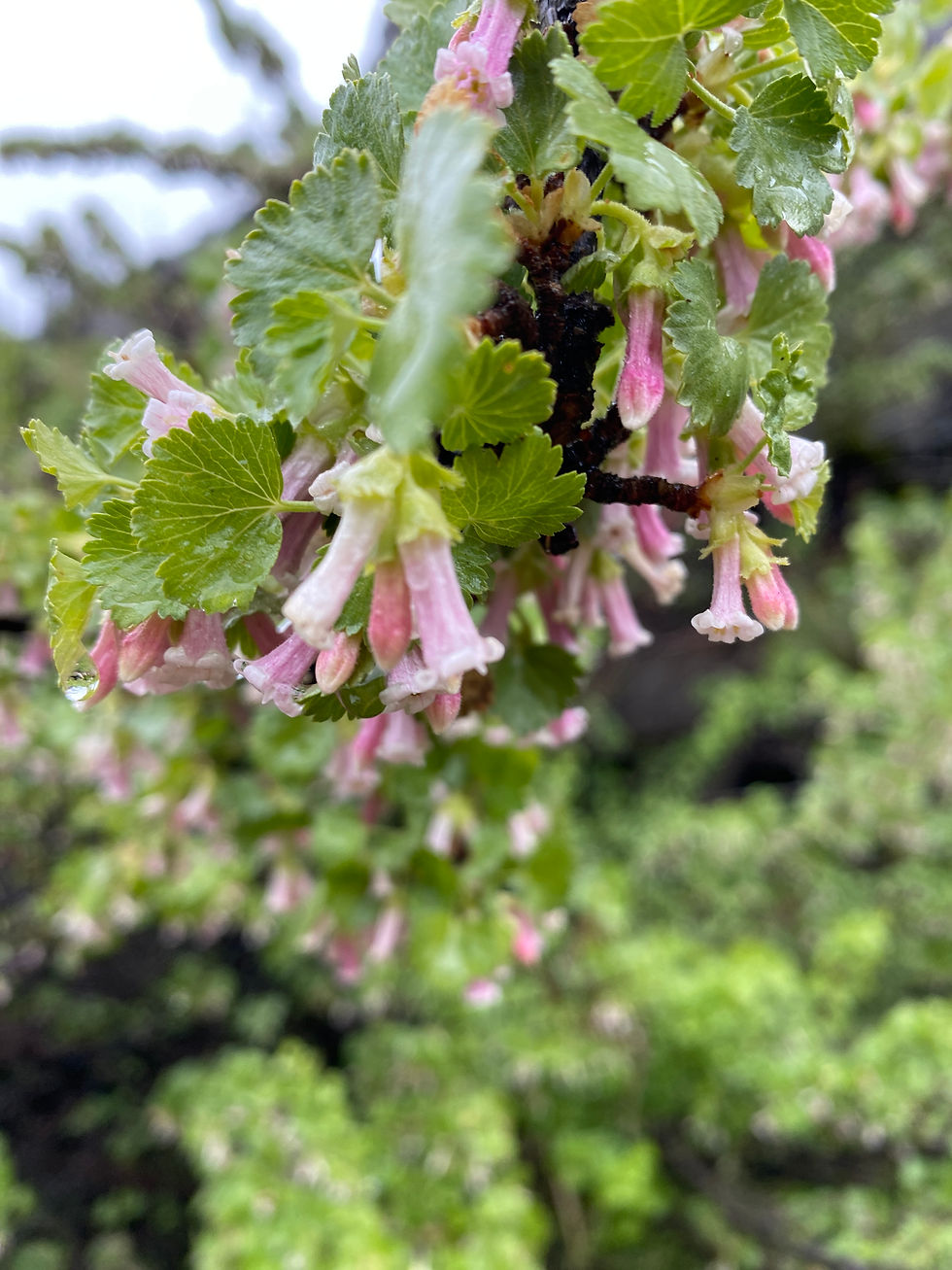Gooseberry Crumble Recipe
- Breanna Gunderson
- Aug 31, 2023
- 4 min read
Updated: Jul 19

Often overlooked and underappreciated, Oregon’s native gooseberries (Ribes spp.) are small, tart, and incredibly resilient shrubs that thrive in a wide range of habitats.
With their spiny stems, bell-shaped flowers, and translucent fruits, gooseberries are a hidden gem in Oregon’s native foodscape—and a fantastic addition to urban food forests.
Here is a great gooseberry crumble recipe to get the ball rolling:
1. Gooseberry Crumble:
Ingredients:
3 cups fresh gooseberries, topped and tailed
1/2 cup granulated sugar (adjust based on the sweetness of the gooseberries)
1 cup all-purpose flour
1/2 cup rolled oats
1/2 cup brown sugar
1/2 cup unsalted butter, cold and cubed
1/2 teaspoon cinnamon
Pinch of salt
Instructions:
Preheat the oven to 350°F (175°C).
In a bowl, toss the gooseberries with granulated sugar. Transfer the mixture to a baking dish.
In a separate bowl, combine the flour, rolled oats, brown sugar, cinnamon, and salt.
Add the cold cubed butter to the dry ingredients. Use your fingers or a pastry cutter to work the butter into the mixture until it resembles coarse crumbs.
Sprinkle the crumble mixture evenly over the gooseberries.
Bake in the preheated oven for about 25-30 minutes, or until the crumble topping is golden and the gooseberries are bubbling.
Allow the crumble to cool slightly before serving. Enjoy it with a scoop of vanilla ice cream or a dollop of whipped cream.
Oregon’s Native Gooseberry Species

There are three gooseberry species native to Oregon, each with its own preferred habitat, growth habit, and fruiting season:
1. Straggly Gooseberry (Ribes divaricatum)
Also called wild gooseberry or coastal black gooseberry
Habitat: Moist woods, streambanks, and lowland forests—especially west of the Cascades
Fruit: Dark purple-black, juicy, tart-sweet with edible skin
Where to find it: Forest Park, Tryon Creek, Columbia River Gorge, Coast Range trails
Best for urban gardens: Yes – compact, shade-tolerant, and highly wildlife-friendly
2. Sticky Currant (Ribes viscosissimum)
Technically a currant but included here due to similar form and fruit
Habitat: Montane meadows, dry slopes, forest edges—often east of the Cascades
Fruit: Blue-black, very tart, slightly sticky to the touch
Where to find it: Mt. Hood National Forest, Deschutes National Forest, Wallowa Mountains
Garden use: Best in naturalistic dryland or high-elevation-style gardens
3. Sierra Gooseberry (Ribes roezlii)
A high-elevation species with showy flowers and fierce spines
Habitat: Dry, open forests and slopes in southern Oregon
Fruit: Red with long spines, edible with careful processing
Where to find it: Siskiyous, Klamath Mountains, upper Rogue River area
Garden use: Good for dryland food forests or wildlife hedgerows—if you're not afraid of thorns
Where to Find Native Gooseberries in the Wild
You’ll often find wild gooseberries:
Along forest edges and shaded slopes
In moist areas near creeks and seeps (especially R. divaricatum)
In dry, open mountain forests (especially R. roezlii and R. viscosissimum)
Great trails to spot native gooseberries:
Wahkeena Falls Trail – R. divaricatum
Silver Falls State Park – R. divaricatum
Mount Ashland Meadows – R. roezlii
Upper Deschutes River Trail – R. viscosissimum
Applegate Lake Trails – multiple species overlap
Look for arching, thorny stems, small maple-like leaves, and dangling pink to red flowers in spring, followed by grape-sized fruit in summer.
When to Harvest & How to Tell They’re Ripe
Native gooseberries typically ripen from late June through August, depending on elevation and species.
You’ll know they’re ripe when:
Fruit turns from green to deep purple, blue, or red (depending on species)
Berries are slightly soft to the touch
They release easily from the stem with a light tug
How to Harvest Gooseberries
Gooseberries are armed with serious spines—wear gloves or harvest carefully with tongs or a berry comb.
Use a small basket or rigid container (they crush easily)
Be selective: unripe berries are bitter and less flavorful
Clean thoroughly—some species have sticky or resinous skin
Note: While Ribes species can host white pine blister rust (a fungal disease harmful to white pines), Oregon’s native species are part of balanced ecosystems and pose minimal risk in urban or backyard settings.

Are They Edible?
Yes! All of Oregon’s native gooseberries are edible.
R. divaricatum is the tastiest—rich, slightly sweet, and excellent raw or cooked
R. roezlii and R. viscosissimum are more tart and seedy—better in jam, syrup, or cooked down
Great for pies, preserves, sauces, or dried like currants
Indigenous communities have long used gooseberries as a seasonal food, often mixing them with other berries or drying them into cakes for winter use.
Who Benefits from Gooseberries?
These plants are more than food for humans—they support entire ecosystems:
Hummingbirds and native bees feed on early spring flowers
Birds, chipmunks, and bears eat the berries
Thickets offer nesting cover for small birds and amphibians
Insects overwinter in their dense branches
Roots stabilize slopes and prevent erosion
Gooseberries are particularly valuable in edge habitats, acting as a transitional species between forest and meadow.
Growing Native Gooseberries in Your Yard
Gooseberries are hardy, adaptable shrubs for gardens focused on pollinators, wildlife, and food. They're especially well-suited for:
Forest-edge hedgerows
Rain gardens or seasonally wet soils (R. divaricatum)
Dryland native gardens (R. roezlii, R. viscosissimum)
Shaded understory or part sun beds
Growing Tips:
Space 3–5 feet apart in well-draining soil
Mulch heavily with leaf litter or woodchips
Water during establishment, then let the plant naturalize
Prune sparingly—many birds nest in the thorny tangle
Urban Rewilding & the Gooseberry Guild
At Urban Rewilding, we design gardens and food forests that go beyond beauty. We create functioning ecosystems that support wildlife, purify the air, sequester carbon, and provide food for people. Native gooseberries are a fantastic part of this system: thorny enough to deter deer and raccoons, beautiful in bloom, and productive under harsh conditions.
Whether you want a productive hedgerow, a berry thicket for birds and kids to discover, or an understory layer in your backyard forest, gooseberries deliver.
Benefits of planting native gooseberries:
Minimal care once established
Feed birds, pollinators, and people
Thrive in tough conditions (clay, part shade, seasonal flooding)
Contribute to a diverse, resilient garden ecosystem
If you’re ready to transform your yard into a habitat-rich, edible landscape filled with Oregon natives, we’re here to help you plant for what belongs here—and what’s coming back.


Comments